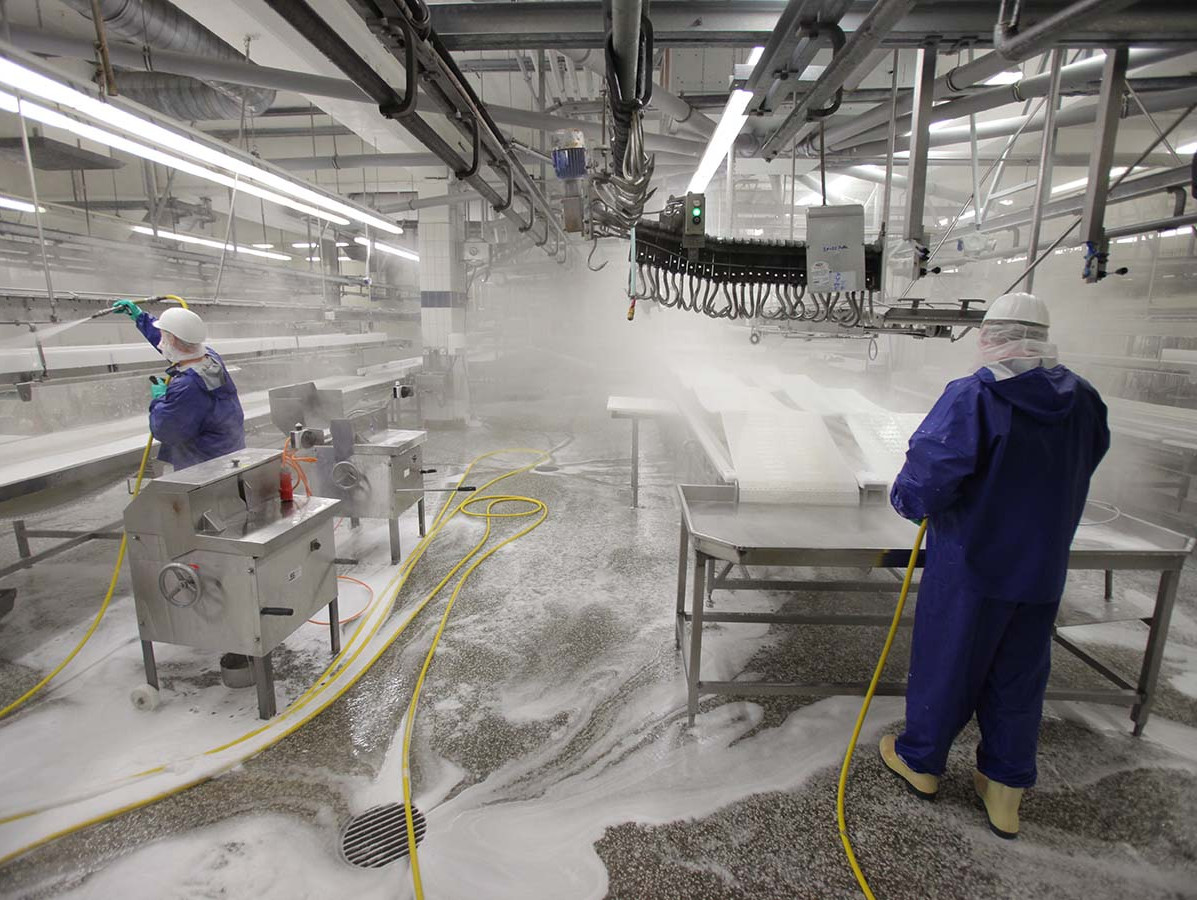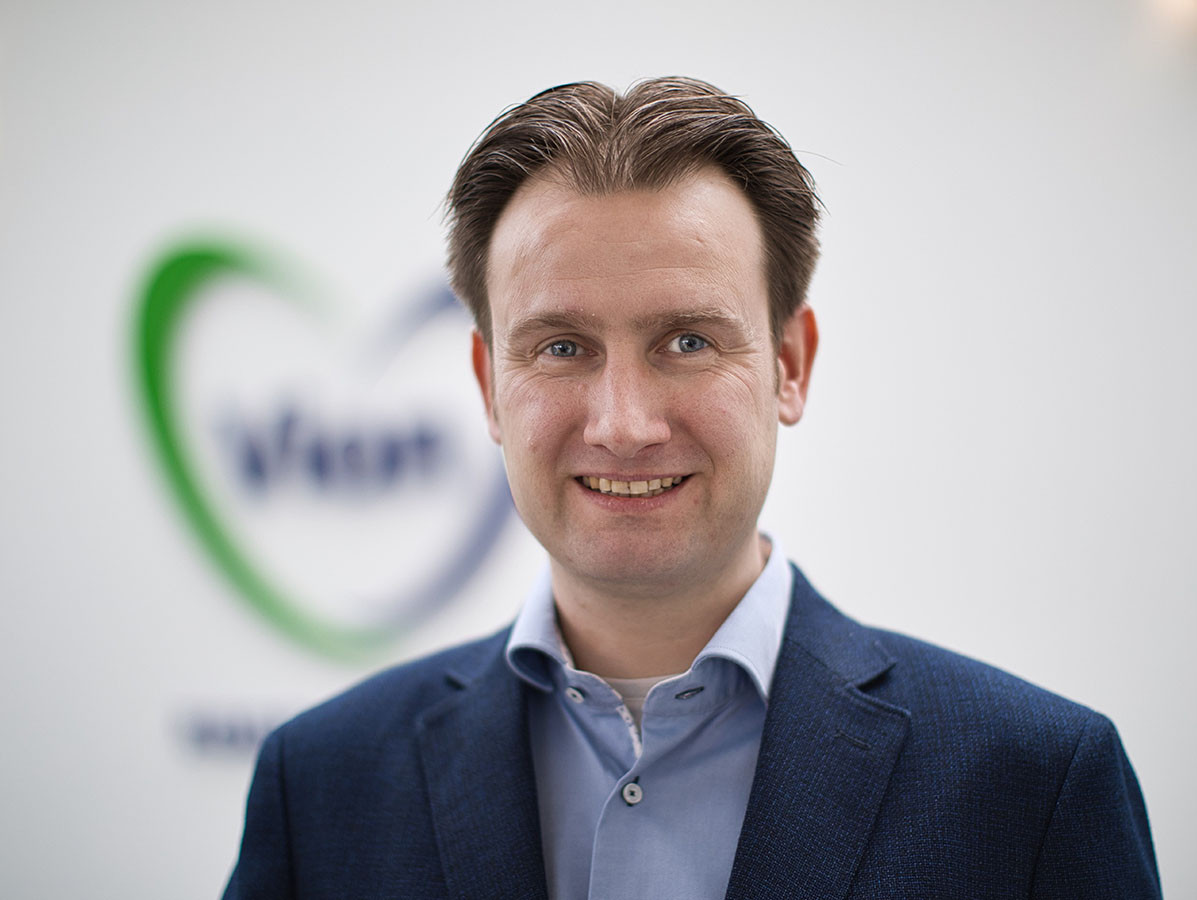
"The cleaning of our production sites, slaughterhouses, cutting plants, and retail locations is an extension of production," says Hugo Pol, Group QA Manager at Vion. "Its execution significantly impacts the quality of our products. That's why we consciously choose an external specialized cleaning company." This is a story about suds, foam, and disinfection. About procedures, monitoring, and verification. Passion for the profession is evident.
At the end of a typical production day at the Vion site in Scherpenzeel, the cleaning process begins. Vion operators disassemble their machines as needed, tidy up, and clear the production space as much as possible. The goal: to leave the space 'sweep clean' for the cleaning to start promptly. "It's our job to ensure that the cleaning company's staff can access everywhere easily and start quickly," says Hugo Pol, who has been with Vion since 2008. "Hygienic design of the production space, equipment, conveyors, and transport means is essential. It's crucial that critical equipment is deeply accessible to the cleaning company for removing leftover product residues."
A brief handover follows, after which the cleaning company's staff gets to work. "They follow standardized procedures," Hugo explains. "The cleaning method is as standardized as possible across all our production sites. We deal with greasy and protein-rich product residues at all locations. The cleaning and disinfection agents we use are tailored to this. Where we have special processes, like smoking bacon or sausages, we use specifically formulated chemicals for cleaning these areas. Slight differences may also arise because the equipment is not identical everywhere. Some machines, for example, are easier to disassemble than others. The extent to which this is possible naturally affects the depth of cleaning applied."
The cleaning begins with rinsing away all physical dirt, followed by the first foam application and cleaning, then rinsing and a visual check where the cleaner ensures all dirt is removed. If satisfied, they proceed to apply disinfectant foam. They monitor the contact time before rinsing it off. Hugo elaborates, "We've been asked to integrate these steps for efficiency, but we firmly oppose this. We distinctly choose this cleaning method with a separate disinfection step using effective surfactants and appropriate contact time."
The cleaning company's final task is another visual final check: is everything truly clean? "Only when the cleaning staff are satisfied with their thorough final inspection do they sign off."
"For optimal hygiene, climate control systems are crucial," Hugo explains. "In the hours after cleaning, ventilation is activated to transition from a warm, humid environment during cleaning to a dry, cooled environment before production starts. At locations where we work two shifts a day, cleaning is carried out in a more compact timeframe. Here, the cleaning and climate control processes need to be adjusted. There is less time to dry and cool the spaces, necessitating more active ventilation." He mentions that before production starts the next morning, a trained Vion employee conducts another visual check of the cleaning. "This is what we call Pre-SSOP monitoring. Pre stands for prior to operations, SSOP for Standard Sanitation Operational Procedure. This daily cleaning monitoring is production's responsibility before starting operations."
"How does it work? Armed with an extensive checklist and a flashlight, this employee inspects the production space, visually checking each item to ensure everything is completely clean, with no broken parts or leaks, that the space is well-cooled, and free of condensation. It's a long list and a serious task. They check not only at eye level but also kneel down to inspect under and behind equipment. These shadowed areas are less well-lit, hence the need for a flashlight. Only when all items are in order is the form signed off, and the employee clears the space for production lines to start," emphasizes Hugo.
It's important that the results of this check are promptly communicated back to the cleaning company. The outcome of the Pre-SSOP monitoring reflects the cleaning company's performance. The first thing the cleaning company does when they arrive at the end of the day is to review and assess Vion's Pre-SSOP monitoring from that morning. "If you conduct thorough and fresh daily checks and actively feedback to the cleaning company, you're much more proactive together. This elevates the execution of cleaning to a higher level. The result is directly visible in the product quality concerning microbiological control. And also in the positive feedback we get from our customers."
"If you conduct thorough and fresh daily checks and actively feedback to the cleaning company, you're much more proactive together.
Additionally, weekly verification takes place on top of daily monitoring, using agars to determine if the disinfection execution is effective enough. This shadow control is performed by someone from our Quality Assurance department. Once a month, we go around with pH paper or specific residue test strips, to verify on top of the visual check that no disinfectant is left behind."
"If you don't conduct in-depth and thorough daily cleaning checks, you have little to report on improvements. The same applies to microbiological analyses of products: If you analyze less, you find less. Can you then say 'I perform well because we hardly ever find anything'? We prefer to turn it around. We monitor and analyze intensively. This provides reliable data, allowing us to demonstrate our performance based on data. Our commercial colleagues, the salespeople, understand that it's not just about producing the right cut, but it's essential to do so under the right hygienic conditions. They can value our final products with our food safety data, especially in critical ready-to-eat product chains."

"Another very important point," Hugo points out, "is the communication in what we call 'the golden triangle': the food company, us as the client; the service provider, the cleaning company; and the chemistry supplier providing the active components. Everything is interconnected: how we set the conditions for good cleaning, what the cleaning company does, and the type of chemistry used. It needs to be balanced and well-coordinated. A valuable tool is the periodic 'cleaning audit,' involving all parties from the triangle. This fosters mutual understanding."
"The chemistry supplier is asked to assess the cleaning execution based on their expertise. What's going well and what can be improved? This cleaning inspection results in a report with concrete actions for each triangle participant. For example, regarding the type of chemistry we use and how it's applied, how we prepare the equipment and environment, and the extent to which the equipment can be deeply cleaned. We also look at the cleaning sequence; what's most efficient? Another disinfectant, with effective surfactants that better penetrate crevices, corners, and gaps, can greatly improve the effectiveness of disinfection.
It's always motivating to create an action list together to further enhance cleaning effectiveness."
As Vion also values sustainability, there's a strong focus on the use of chemistry and water. "The daily recurring challenge is how to accomplish complete cleaning in a compact timeframe. This determines the type and amount of chemistry used, which in turn affects water usage. The principle is that sustainability measures should not negatively impact food safety control."
In addition to this cleaning audit, Hugo recently organized an 'early-rise session' at Vion. "We see this as a calibration session. The goal is to learn from each other, check if we're all performing the procedures the same way and verify correctly. We met at 4:30 a.m. at one of our sites with colleagues from all quality teams; from our beef and pork slaughterhouses to retail and plant-based production sites. Everyone had a notepad and flashlight. It's particularly important that everyone is consciously engaged with the question: 'How and where should you look during the pre-SSOP?' I was positively surprised. It was great to see how enthusiastic and detailed the colleagues conducting the checks were. People bending and kneeling, checking thoroughly for a comprehensive verification of the cleaning. Afterwards, we discuss, review the procedures, and share tips & tricks. And, of course, enjoy a lovely breakfast. Soon, we have our quarterly quality managers meeting. There, our chemistry supplier will talk about expected changes in legislation and explain the differences between the various active ingredients in cleaning and disinfecting agents. Being so actively and constructively engaged in hygiene and cleaning motivates me. And I see this reflected in the group of colleagues from different Vion production sites."
"Our cleaning process is so critical because we know the quality of its execution is strongly linked to the microbiological quality of our products. Especially at locations where we produce raw materials for fresh ready-to-eat products like tartare and filet americain, pathogen control is of great importance. We demonstrate this performance through intensive microbiological monitoring of our products at every stage of production. At Vion, our team invests a lot of energy in hygienic slaughtering and cutting and in excellent cleaning; all to ensure we can produce critical raw materials for tasty and safe food products. Stable chains for the production of safe raw materials are increasingly important. The basis is being able to trust each other and inform each other about microbiological performance in the chain."
It's characteristic of Hugo: a positive attitude, always looking for ways to improve. "I enjoy a constructive collaboration with all the different parties involved. By investing in quality and optimizing hygiene management, we are able to supply critical customers with safe raw materials for tasty consumer products. It's important that consumers can trust the brand or name of our customer. The daily execution of good cleaning is the foundation to achieve this."
Photos: ©Vion
Source: vakblad Voedingsindustrie 2023